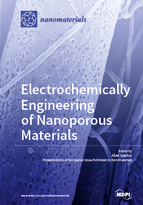Electrochemically Engineering of Nanoporous Materials
A special issue of Nanomaterials (ISSN 2079-4991).
Deadline for manuscript submissions: closed (31 March 2018) | Viewed by 55295
Special Issue Editor
Interests: structural engineering of nanoporous materials; photocatalysis and energy; nanophotonics and plasmonics; optical sensing and biosensing; smart drug delivery from nanocarriers and surface coatings for biomedical applications; microfluidic lab-on-a-chip systems for all-in-one sensing applications
Special Issues, Collections and Topics in MDPI journals
Special Issue Information
Dear Colleagues,
Electrochemical engineering of nanoporous materials is a cost-effective and facile synthesis approach that enables the production of a range of nanoscale materials with controllable dimensions and properties. Recent decades have witnessed extensive research activity into the advanced engineering of nanoporous materials, from fundamental studies to applied science. These nanomaterials offer a set of unique and exclusive advantages for a wealth of applications, including catalysis, energy storage and harvesting, electronics, photonics, sensing, templates, and membranes.
This Special Issue is dedicated to recent research advances in electrochemical engineering of nanoporous materials and their application across several disciplines and research fields. The broad and interdisciplinary applicability of these nanomaterials will be of profound and immediate interest for a broad audience, ranging from physicists, chemists, engineers, materials scientists, bioengineers, and nanomedicine experts.
Dr. Abel Santos
Guest Editor
Manuscript Submission Information
Manuscripts should be submitted online at www.mdpi.com by registering and logging in to this website. Once you are registered, click here to go to the submission form. Manuscripts can be submitted until the deadline. All submissions that pass pre-check are peer-reviewed. Accepted papers will be published continuously in the journal (as soon as accepted) and will be listed together on the special issue website. Research articles, review articles as well as short communications are invited. For planned papers, a title and short abstract (about 100 words) can be sent to the Editorial Office for announcement on this website.
Submitted manuscripts should not have been published previously, nor be under consideration for publication elsewhere (except conference proceedings papers). All manuscripts are thoroughly refereed through a single-blind peer-review process. A guide for authors and other relevant information for submission of manuscripts is available on the Instructions for Authors page. Nanomaterials is an international peer-reviewed open access semimonthly journal published by MDPI.
Please visit the Instructions for Authors page before submitting a manuscript. The Article Processing Charge (APC) for publication in this open access journal is 2900 CHF (Swiss Francs). Submitted papers should be well formatted and use good English. Authors may use MDPI's English editing service prior to publication or during author revisions.
Keywords
- Electrochemical Etching
- Anodization
- Fabrication of nanoporous materials
- Nanoporous materials for sensing and biosensing
- Nanoporous materials for biomedical applications
- Nanoporous materials for energy storage and harvesting
- Nanoporous materials for catalysis
- Nanoporous materials for membrane science
- Nanoporous materials for electronics
- Nanoporous materials for optics and photonics







